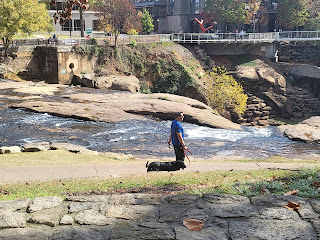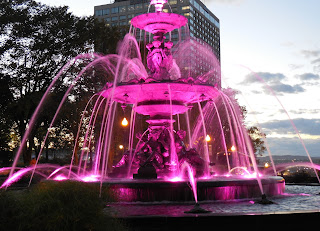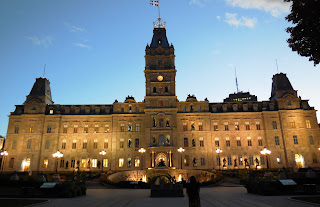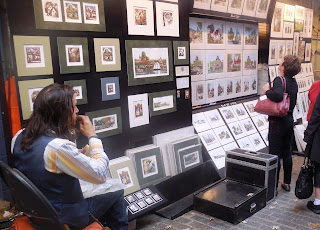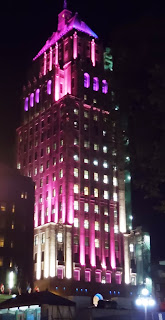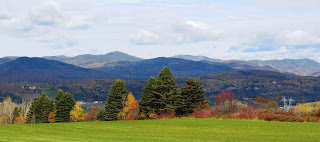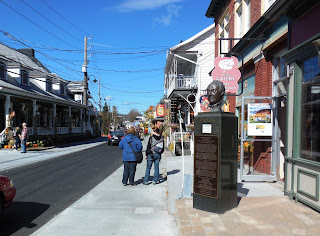History buffs love visiting the Gettysburg battlefield to learn about the infamous and bloody three-day battle. Over the years, I've visited the area many times, even touring the battlefield via Segway, which in my opinion is the best way to do it.
I've also taken ghost tours, which can be filled with historical tidbits and can be very interesting, as well.
However, my favorite thing to do is simply stroll around the downtown area, enjoying the little boutique shops, dining at the restaurants, taking part in tastings at the wineries and learning more about some of the structures identified by historical markers.
 |
| A tasting at Reid's Winery Tasting Room and Cider House on Baltimore Street. |
 |
| This beautiful building once served the community as a parking garage. |
After I got over the notion that this beautiful building was used for parking, Gottfried took me on a tour where he offered details on other points of interest and I left knowing much more about the interesting and walkable downtown area.
Historical Houses
The Will's House
 |
| "Return Visit" is built to scale. |
One of the most-oft photographs of downtown Gettysburg is the statue of Lincoln standing beside a tourist near the David Wills House, where he worked on his famous Gettysburg Address. Artist J. Seward Johnson, Jr., of Johnson & Johnson pharmaceutical fame, was responsible for creating the now-famous piece, which shows Lincoln pointing up at the room in which he stayed. I've always been rather fascinated with Seward Johnson's life-like sculptures. You can view more of them at the Grounds for Sculpture in New Jersey. Once you've seen a Seward Johnson piece, you'll recognize it immediately. (You can see more of Seward Johnson's work and read about the Grounds for Sculpture in a blog I wrote here). This statue that stands on the Gettysburg square is called "Return Visit."
The Will's House, for a long time, charged admission. Today it is free and contains six galleries and two rooms that have been restored to their 1863 appearance.
The Farnsworth House
The Farnsworth House Inn not only serves as a Bed and Breakfast, but also as a place to stop and have a bite to eat after a day of touring.
The Inn was named after Brigadier
General Elon John Farnsworth of the Union Army, who died in battle along with
65 of his men after being ordered by Major General Hugh Judson Kilpatrick to lead an unsuccessful charge against Confederate positions south of the Devil’s Den
area.
The back part of the house, now featuring Sweney’s Tavern, was built in 1808, while the front of the house was added in 1833. Banker John
McFarland, who built the house, fell on hard times and sold it to the Sweney
family, who owned it during the battle.
Furious fighting began almost immediately when the
Confederates inhabited the house during the very first day of the war. Confederate sharpshooters positioned themselves
at a tiny window in the attic, shooting towards Cemetery Hill while laying on their
stomachs. In fact, the shot that killed Jenny Wade, the only
civilian directly killed in the battle, was said to have come from that very
window. More than 100 bullet holes now riddle the walls of the house.
The Shriver House
Another interesting house near downtown is the Shriver House Museum and one that is foremost in my mind because of how I felt during a tour of the place. As we gathered around a docent, I began to feel a debilitating pain my stomach as if someone was twisting my insides. This was followed by a bit of panic and sweating and I wrestled with interrupting the docent by telling her, or fleeing, but I stuck it out, not wanting to create a scene and the feeling passed within a few minutes.
I learned later that the house was used as a hospital during the war. Was I feeling the way one of those soldiers felt after being shot in the stomach? I guess I'll never know.
Tourists who want to learn how people lived in the period of time before, during and after the Civil War get a clearer picture after visiting the Shriver House.
In the attic is a sharpshooter's nest where two confederates died.
 |
| Sharpshooter's nest in the attic of the Shriver House. |
 |
| The Majestic Theater dates back to 1925. |
Downtown Gettysburg is also home to the Majestic Theater, which dates back to 1925 and at the time was known as the largest vaudeville and silent movie theater in south-central Pennsylvania.
 |
| LARK carries this cute selection of clocks that I'm always tempted to buy. |
One of my favorite places is LARK, especially during the Christmas season. If you're at a loss as to what to buy as a gift for someone who seemingly has everything, LARK is the place to go.The 5,000 square foot shop, which opened in 2011, is located in an historic building located at 17 Lincoln Square on one of the original 210 lots developed in 1785 by James Gettys.
Other shops downtown offer everything from art, to home decor, jewelry, apparel and more. Gallery 30, at 26 York Street, is another shop you won't want to miss. Below are a few shots of the many interesting and beautiful items that they sell.
 |
| The Garryowen Irish Pub is the only Irish-owned pub in Gettysburg. |
 |
| The Mahogany bar at the Garryowen at an unusual time before patrons arrived. |
These are just a few of the places I enjoy when I visit Gettysburg. You may also be interested to know that, for such a historical place, it's not very crowded and parking is reasonable compared to many other places I've visited.

.JPG)





